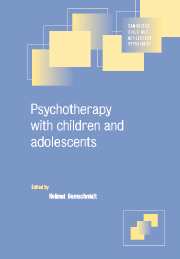Book contents
- Frontmatter
- Contents
- List of contributors
- Preface
- Part I Principles of psychotherapy with children, adolescents and families
- Part II Psychotherapeutic methods and settings
- Part III The practice of psychotherapy for specific disorders in childhood and adolescence
- 15 Anxiety disorders
- 16 Obsessive-compulsive disorder
- 17 Depressive syndromes and suicide
- 18 Dissociative [conversion] disorders
- 19 Disorders of sexual development and sexual behaviour
- 20 Substance abuse and addiction
- 21 Eating disorders
- 22 Psychotherapy in chronic physical disorders
- 23 Enuresis and faecal soiling
- 24 Dyslexia and dyscalculia
- 25 Stuttering
- 26 Hyperkinetic disorders
- 27 Autism
- 28 Schizophrenia
- 29 Conduct disorders, antisocial behaviour, delinquency
- 30 Physical abuse and neglect
- 31 Sexual abuse and sexual maltreatment
- Part IV The practice of psychotherapy in various settings
- Index
29 - Conduct disorders, antisocial behaviour, delinquency
- Frontmatter
- Contents
- List of contributors
- Preface
- Part I Principles of psychotherapy with children, adolescents and families
- Part II Psychotherapeutic methods and settings
- Part III The practice of psychotherapy for specific disorders in childhood and adolescence
- 15 Anxiety disorders
- 16 Obsessive-compulsive disorder
- 17 Depressive syndromes and suicide
- 18 Dissociative [conversion] disorders
- 19 Disorders of sexual development and sexual behaviour
- 20 Substance abuse and addiction
- 21 Eating disorders
- 22 Psychotherapy in chronic physical disorders
- 23 Enuresis and faecal soiling
- 24 Dyslexia and dyscalculia
- 25 Stuttering
- 26 Hyperkinetic disorders
- 27 Autism
- 28 Schizophrenia
- 29 Conduct disorders, antisocial behaviour, delinquency
- 30 Physical abuse and neglect
- 31 Sexual abuse and sexual maltreatment
- Part IV The practice of psychotherapy in various settings
- Index
Summary
Definition and classification
The terms conduct disorder and antisocial behaviour are used to describe behaviour which deviates from generally accepted social norms, whereas the term delinquency is used to describe breaches of law. These definitions cover a wide spectrum of behavioural disorders ranging from frequent arguing, lying, running away and playing truant, through to violent crime (Sholevar, 1995; Quay and Hogan, 1999).
ICD-10 (WHO, 1992) distinguishes six types of ‘conduct disorder’ (F91). These are: ‘conduct disorder confined to the family context’ (F91.0), ‘socialized conduct disorder’ (F91.1), ‘unsocialized conduct disorder’ (F91.2), ‘oppositional defiant disorder’ (F91.3) and two remaining categories for ‘other’ and ‘unspecified’ conduct disorders.
F91.0 and F91.3 most frequently occur in younger children and may have a better prognosis. F91.1 and F91.2 are determined by the nature of the child's or adolescent's bonding, rather than whether the antisocial behaviour occurs alone or in a group.
Conduct disorders may also be classified under other diagnostic categories, such as ‘hyperkinetic conduct disorder’ (F90.1) and ‘mixed disorders of conduct and emotions’ (F92). Because of their specific features, these disorders usually require a different approach to treatment.
Epidemiology
Conduct disorders are common in childhood and adolescence. Depending on the sample, the reported incidence of conduct disorder ranges from 5 to 25% (Malmquist, 1991). One study (Remschmidt and Walter, 1989) which included an entire clinical sample (all in- and outpatients from a rural area with a total population of 450 000) found conduct disorder to be the most common diagnosis (20%) among 12–17-year-old patients.
- Type
- Chapter
- Information
- Psychotherapy with Children and Adolescents , pp. 498 - 511Publisher: Cambridge University PressPrint publication year: 2001

